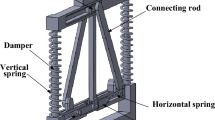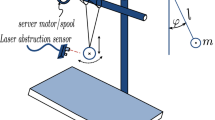Abstract
An approach to the design of models of dynamical systems with high dry friction in the kinematic pair is developed. The members of the kinematic pair are represented by parts of rigid bodies. The system as a whole is considered to have a variable structure. According to this assumption, two modes of motion with different dissipative characteristics are possible. The states in which the modes exchange and the motion switches over into critical modes with dynamic self-locking are established. A system with a variable transfer function between members that form a nonideal constraint is described
Similar content being viewed by others
References
I. I. Artobolevskii, Theory of Mechanisms [in Russian], Nauka, Moscow (1965).
V. L. Veits, A. E. Kochura, and A. M. Martynenko, Dynamic Analysis of Machine Drives [in Russian], Mashinostroenie, Leningrad (1971).
S. N. Kozhevnikov, “On the paradoxes of Painlevé,” Int. Appl. Mech., 3, No. 1, 69–73 (1967).
S. N. Kozhevnikov, Theory of Mechanisms and Machines [in Russian], Mashinostroenie, Moscow (1973).
S. N. Kozhevnikov, E. Ya. Antonyuk, and V. M. Matiyasevich, “Dynamic processes in mechanisms with inertial self-locking chains,” Int. Appl. Mech., 21, No. 10, 1000–1005 (1985).
S. N. Kozhevnikov, Ya. I. Esipenko, and Ya. M. Raskin, Mechanisms [in Russian], Mashinostroenie, Moscow (1976).
N. I. Kolchin, “On the dynamics of self-locking systems,” Tr. Leningr. Politekhn. Inst., 254, 5–13 (1965).
A. I. Korendyasev and L. I. Tyves, “Dynamics of a wedge analog of mechanisms,” Mashinovedenie, No. 3, 30–34 (1971).
P. Painlevé, Lectures on Friction [in French], Hermann, Paris (1895).
A. I. Turpaev, Self-Locking Mechanisms [in Russian], Mashinostroenie, Moscow (1976).
E. Ya. Antonyuk and N. P. Plakhtienko, “Dynamic modes of one seismic-damping mechanism with frictional bonds,” Int. Appl. Mech., 40, No. 6, 702–708 (2004).
E. Ya. Antonyuk and N. P. Plakhtienko, “Dynamic processes in a spheroidal seismic-damping mechanism,” Int. Appl. Mech., 41, No. 1, 90–97 (2005).
A. A. Martynyuk and N. V. Nikitina, “Complex oscillations revisited,” Int. Appl. Mech., 41, No. 2, 179–186 (2005).
N. P. Plakhtienko, “Nonlinear translational vibrations of a solid with a gravity-friction seismic damper,” Int. Appl. Mech., 39, No. 9, 1093–1098 (2003).
N. P. Plakhtienko, “Nonlinear one-dimensional seismodynamic model of a solid with shock absorbing supports,” Int. Appl. Mech., 41, No. 3, 336–344 (2005).
V. F. Ushkalov and M. M. Zhechev, “Dynamic analysis of the bolster-wedges-sideframes subsystem of a truck,” Int. Appl. Mech., 38, No. 11, 1407–1413 (2002).
Author information
Authors and Affiliations
Additional information
__________
Translated from Prikladnaya Mekhanika, Vol. 43, No. 5, pp. 97–105, May 2007.
Rights and permissions
About this article
Cite this article
Antonyuk, E.Y. On models of dynamic systems with dry friction. Int Appl Mech 43, 554–559 (2007). https://doi.org/10.1007/s10778-007-0054-2
Received:
Issue Date:
DOI: https://doi.org/10.1007/s10778-007-0054-2




